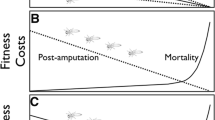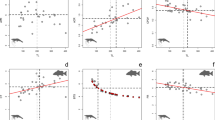Abstract
Autotomy, the discarding of a prey appendage grasped by a predator, may evolve when the benefits of immediate survival outweigh the costs of appendage loss. In larval damselflies, joints connecting lamellae to the abdomen vary in size and shape within and among taxa suggesting that they may evolve under selection by invertebrate predators, such as dragonfly larvae. Assuming that joint width is proportional to the force required for autotomy, we tested if invertebrate predation favours smaller lamellar joints for autotomy or larger joints for structural support of lamellae for swimming. We compared the maximum joint widths of larval Lestes and Enallagma among ponds that varied in risk of invertebrate predation. Relative predation risk estimated as the frequency of regenerated lamellae within ponds was weakly and positively related to the relative abundance of larval dragonflies. The allometry of lamellar joint size decreased with increasing risk of invertebrate predation across ponds after controlling for variation in body size in Lestes congener but not in Enallagma species. Both species of Lestes had larger joint sizes than the five species of Enallagma, suggesting that the ancestral divergence of lamellar joints between these genera may influence contemporary responses to invertebrate predation.



Similar content being viewed by others
References
Anholt BR (1990) Size-biased dispersal prior to breeding in a damselfly. Oecologia 83:385–387
Anholt BR (1994) Cannibalism and early instar survival in a larval damselfly. Oecologia 99(1):60–65
Arnold SJ (1983) Morphology, performance and fitness. Am Zool 23(2):347–361
Arnold EN (1988) Caudal autotomy as a defense. In: Gans C, Huey RB (eds) Biology of the reptilia, vol 16. Liss, New York, pp 235–274
Baker L, Dixon SM (1986) Wounding as an index of aggressive interactions in larval Zygoptera (Odonata). Can J Zool 64:893–897
Bright E, O’Brien MF (1999) Odonata larvae of Michigan: keys for, and notes on, the dragon- and damselfly larvae found in the State of Michigan. University of Michigan Museum of Zoology—Insect Division, Michigan, US. Available from http://insects.ummz.lsa.umich.edu/MICHODO/test/HOME.HTM. Accessed June 2010
Burnside CA, Robinson JV (1995) The functional morphology of caudal lamellae in coenagrionid (Odonata: Zygoptera) damselfly larvae. Zool J Linn Soc Lond 114:155–171
Corbet PS (1980) Biology of Odonata. Ann Rev Entomol 25:189–217
Diego-Rasilla FJ (2003) Influence of predation pressure on the escape behaviour of Podarcis muralis lizards. Behav Process 63:1–7
Edeline E, Carlson SM, Stige LC, Winfield IJ, Fletcher JM, James JB, Haugen TO, Vøllestad LA, Stenseth NC (2007) Trait changes in a harvested population are driven by a dynamic tug-of-war between natural and harvest selection. Proc Natl Acad Sci USA 104:15799–15804
Eriksen CH (1986) Respiratory roles of caudal lamellae (gills) in a lestid damselfly (Odonata: Zygoptera). J North Am Benthol Soc 5(1):16–27
Fleming PA, Muller D, Bateman PW (2007) Leave it all behind: a taxonomic perspective of autotomy in invertebrates. Biol Rev 82:481–510
Gyssels FGM, Stoks R (2005) Threat-sensitive responses to predator attacks in a damselfly. Ethology 111:411–423
Johansson F, Rowe L (1999) Life history and behavioral responses to time constraints in a damselfly. Ecology 80(4):1242–1252
Johnson DM (1991) Behavioral ecology of larval dragonflies and damselflies. Trends Ecol Evol 6(1):8–13
Kirkpatrick M (2009) Patterns of quantitative genetic variation in multiple dimensions. Genetica 136:271–284
Langerhans RB, DeWitt TJ (2004) Shared and unique features of evolutionary diversification. Am Nat 164:335–349
Langerhans RB, Makowicz AM (2009) Shared and unique features of morphological differentiation between predator regimes in Gambusia caymanensis. J Evol Biol 22:2231–2242
McPeek MA (1989) Differential dispersal tendencies among Enallagma damselflies (Odonata) inhabiting different habitats. Oikos 56:187–195
McPeek MA (1990a) Behavioral differences between Enallagma species (Odonata) influencing differential vulnerability to predators. Ecology 71(5):1714–1726
McPeek MA (1990b) Determination of species composition in the Enallagma damselfly assemblages of permanent lakes. Ecology 71(1):83–98
McPeek MA (1995) Morphological evolution mediated by behavior in the damselflies of two communities. Evolution 49(4):749–769
McPeek MA (1997) Measuring phenotypic selection on an adaptation: lamellae of damselflies experiencing dragonfly predation. Evolution 51(2):459–766
McPeek MA, Schrot AK, Brown JM (1996) Adaptation to predators in a new community: swimming performance and predator avoidance in damselflies. Ecology 77(2):617–629
McPeek MA, Grace M, Richardson JML (2001) Physiological and behavioral responses to predators shape the growth/predation risk trade-off in damselflies. Ecology 82(6):1535–1545
Pierce CL, Crowley PH, Johnson DM (1985) Behavior and ecological interactions of larval Odonata. Ecology 66(5):1504–1512
Robinson JV, Hayworth DA, Harvey MB (1991a) The effect of caudal lamellae loss on swimming speed of the damselfly Argia moesta (Hagen) (Odonata: Coenagrionidae). Am Midl Nat 125(2):240–244
Robinson JV, Shaffer LR, Hagemeier DD, Smatresk NJ (1991b) The ecological role of caudal lamellae loss in the larval damselfly, Ischnura posita (Hagen) (Odonata: Zygoptera). Oecologia 87:1–7
Schmidt E (1919) Uber das schwimmen der libellenlarvae. Zool Anz 50:235–237
Slos S, De Block M, Stoks R (2009) Autotomy reduces immune function and antioxidant defence. Biol Lett 5:90–92
Stoks R (1998) Effect of lamellae autotomy on survival and foraging success of the damselfly Lestes sponsa (Odonata: Lestidae). Oecologia 117(3):443–448
Stoks R, De Block M (2000) The influence of predator species and prey age on the immediate survival value of antipredator behaviours in a damselfly. Arch Hydrobiol 147:417–430
Stoks R, McPeek MA (2006) A tale of two diversifications: reciprocal habitat shifts to fill ecological space along the pond permanence gradient. Am Nat 168:S50–S72
Stoks R, De Block M, Van Gossum H, Valck F, Lauwers K, Verhagen R, Matthysen E, De Bruyn L (1999) Lethal and sublethal costs of autotomy and predator presence in damselfly larvae. Oecologia 120:87–91
Stoks R, McPeek MA, Mitchell JL (2003) Evolution of prey behavior in response to changes in predation regime: damselflies in fish and dragonfly lakes. Evolution 57(3):574–585
Strobbe F, McPeek MA, De Block M, Stoks R (2011) Fish predation selects for reduced foraging activity. Behav Ecol Sociobiol 65(2):241–247
Tillyard RJ (1917) On the morphology of the caudal gills of the larvae of zygopterid dragonflies. Parts i, ii. Proc Linn Soc NSW 42:31–112
Wainwright PC, Reilly SM (eds) (1994) Ecological morphology: integrative organismal biology. University of Chicago Press, Chicago, pp 42–59
Acknowledgments
M. Reynolds provided expertise in larva identification and assisted with estimating the frequency of lamellar regeneration. A. Brown, M. Edwards, and K. O’Brien contributed to field sampling, and along with E. Smyth, A. Shingleton and two anonymous reviewers made constructive comments that benefitted this work. This work was supported by a grant from NSERC Canada to B.W.R.
Author information
Authors and Affiliations
Corresponding author
Electronic supplementary material
Below is the link to the electronic supplementary material.
Rights and permissions
About this article
Cite this article
Bose, A.P.H., Robinson, B.W. Invertebrate predation predicts variation in an autotomy-related trait in larval damselfly. Evol Ecol 27, 27–38 (2013). https://doi.org/10.1007/s10682-012-9581-3
Received:
Accepted:
Published:
Issue Date:
DOI: https://doi.org/10.1007/s10682-012-9581-3




